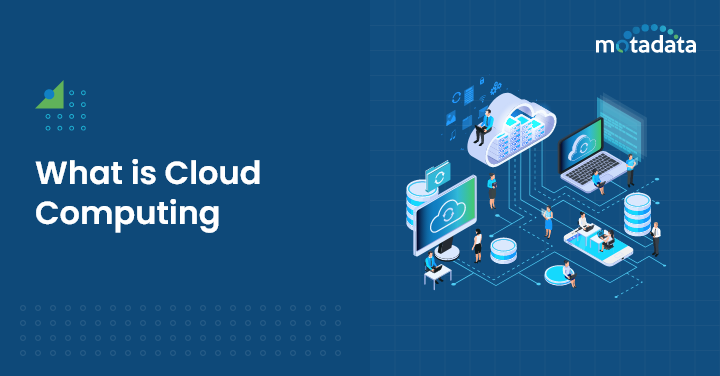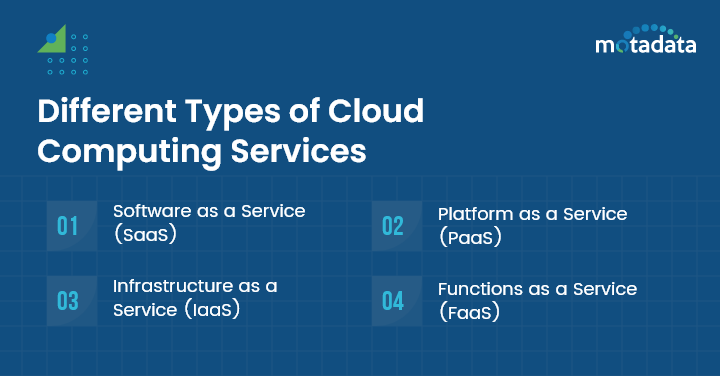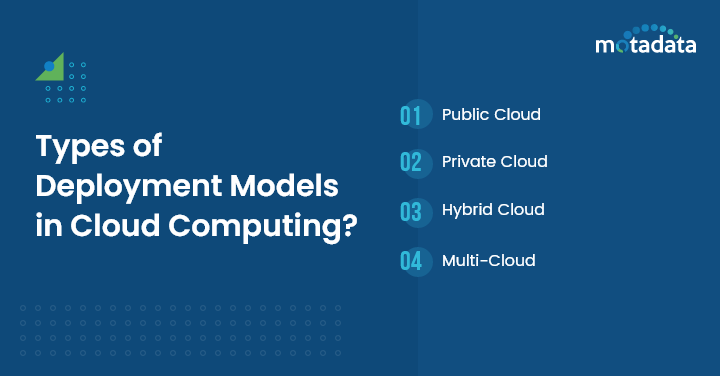Do you know that the global cloud computing market is projected at $2,321 billion by the year 2032? Yes, you saw that right. Cloud computing growth is galloping at a CAGR of 16%. And why not? Cloud computing offers businesses an opportunity to rent their IT services rather than having them on their on-site data center. It helps companies to leverage ready-made IT resources that unlock a unique set of business benefits.
Cloud computing has amazing business benefits. But, to implement them, you must understand it clearly. You must know different types of cloud computing services, their use cases, examples, advantages, disadvantages, and many more. And that’s exactly what we are going to explore in this blog. So, let’s begin with the definition first.
What is Cloud Computing?

Cloud computing is an on-demand access of different computing services like servers, intelligence, databases, storage, analytics, and networking.
The access here is through the internet; hence it is called cloud computing.
It has pay-as-you-go pricing and it helps you to:
- Lower your operating costs
- Run infrastructure efficiently
- Scale as per your business needs
Types of Cloud Computing Services
1. SaaS
SaaS has become a buzzword with the advent of hundreds of SaaS companies in the recent past. But I am sure many of you might be thinking what exactly is SaaS? Well, the answer lies in its name itself. Software as a Service (SaaS) is a method of delivering software by allowing multiple users to access it. The mode of access for users is remote via the internet where the user pays a subscription fee in return.
This distribution model enables SaaS providers to eliminate the need for:
- Installation
- Storage space
- Data loss
Use Cases & Examples
SaaS has a range of use cases that helps different components of businesses to work more efficiently. Let’s have a look at some of the top SaaS use cases along with a few examples.
Sales Enablement
SaaS Sales enablement tools helps sales teams to sell more effectively by providing them with features for:
- Lead management
- Communication
- Analytics
Examples: Salesforce Sales Cloud and HubSpot Sales Hub
Design
Design SaaS applications offer graphic designers the tools and resources they need, helping them to create visually appealing designs while also improving photo backgrounds for enhanced visual impact.
Examples:
Canva and Adobe Creative Cloud
Customer Service
Customer service SaaS enables efficient communication between businesses and customers. Ultimately, it helps resolve inquiries quickly through solutions like a cloud contact center software.
Examples: Zendesk and Freshdesk
Metrics and Analysis
These SaaS tools help businesses to take data-driven decisions, track performance, and optimize strategies.
Examples: Google Analytics and Tableau
CRM
SaaS CRM software helps businesses in managing their customer relationships more efficiently. It also boosts their sales and marketing efforts.
Examples: SalesForce CRM and Zoho CRM
Project Management
Project management tools help teams to ensure that all their tasks are completed within the set time and budget.
Advantages
- Lower cost
- Scalability
- Data Storage
- Accessibility
- Operational Management
Disadvantages
- Lack of Control
- Data and Security Concerns
- Regulations Compliance Issues
2. PaaS
PaaS, which stands for Platform-as-a-Service, is one of the popular types of cloud computing services that offers customers a complete cloud platform comprising software, hardware, and infrastructure. Businesses use PaaS to develop, run, and manage applications without bearing the cost, inflexibility, and complexity that comes with on-premises app development and maintenance.
Here, the PaaS provider hosts several things at their data center like:
- Networks
- Servers
- Storage
- Operating system software
- Databases
- Development tools
Use Cases & Examples
Web Application Development
PaaS simplifies web application development by enabling developers to focus on coding and deployment without having to worry about:
- Server Provisioning
- Scalability
- Maintenance
Examples: Heroku and Google App Engine
Mobile App Backend Services
PaaS for mobile app development helps to manage critical backend services like:
- Authentication
- Real-time databases
- Push notifications
It also helps developers to create user-friendly interfaces.
Examples: Firebase and AWS Amplify
Big Data and Analytics
PaaS platforms are also known for streamlining big data and analytics.
They enable organizations to process vast data by eliminating complexities associated with managing distributed systems.
Examples: Azure HDInsight and IBM Watson Studio
DevOps and CI/CD
PaaS platforms automate DevOps processes and enable continuous integration / continuous deployment (CI/CD) pipelines.
They ensure faster and more reliable software delivery by streamlining:
- Code integration
- Testing
- Deployment
Examples: CircleCI and Jenkins
Advantages
- Time Saving
- Scalability
- Faster to Market
- Cost Effective
- Continuous Updates
Disadvantages
- Vendor Lock-in
- Data Privacy
- Integration Issues
3. IaaS
Infrastructure as a Service (IaaS) is a type of cloud computing service that enables customers to rent and manage computing resources such as:
- Servers
- Storage
- Networking
- Virtualization
IaaS is a great choice for those organizations that are looking to migrate to the cloud or want to modernize their existing infrastructure. With IaaS, businesses can adjust their resource allocation as per the changing demands. This considerably reduces the need for large initial investments in physical hardware.
IaaS is best for those startups, enterprises, and IT departments that are looking for benefits like:
- Scalability
- Flexibility
- Cost-efficiency
IaaS Use Cases and Examples
Development and Testing Environments
Organizations can provision several infrastructure components like virtual machines for:
- Development
- Testing
- Quality Assurance
Examples: Amazon EC2 and Azure Virtual Machines
Data Backup and Disaster Recovery
Creating backups and disaster recovery solutions is one of the key IaaS use cases. It helps you store data and run backup services in the cloud, ensuring business continuity and data availability in case of a disaster. Salesforce Backup and Recovery further enhances this by providing automated, secure, and efficient backup solutions tailored for Salesforce data, ensuring rapid recovery and minimal downtime.
Examples: AWS Backup and Azure Site Recovery
Advantages
- Low Capital Expenditure
- Dynamic Scalability
- Pay-as-you-Go Pricing
- Resource Abstraction
- Disaster Recovery
Disadvantages
- Unexpected Cost
- Security Risks
- Third Party Dependency
4. FaaS
Function-as-a-Service (FaaS) is a cloud-based computing service that enables programmers to build, compute, operate, manage application packages, and execute code in response to events, without having to manage complicated infrastructure. FaaS allows cloud clients to not only build apps but also deploy features. And the best part is that they only have to pay when a feature is used.
Use Cases and Examples
Real-time Data Processing and Analytics
FaaS is more than handy when it comes to analyzing real-time data streams. For an instance, you can use FaaS to:
- Process incoming sensor data from IoT devices
- Analyze log files to detect security threats
- Perform sentiment analysis on social media posts while they are being posted
Example: AWS Lambda
Web and Mobile Application Backend
Backend developers looking for web and mobile applications find FaaS extremely cost-effective and scalable. It is because, FaaS enables faster feature deployment by handling infrastructure management while developers use functions for tasks like:
- Database Access
- User Authentication
- Content Delivery
Example: Azure Functions
Event-Driven Automation
FaaS is usually the first choice when it comes to building event-driven automation workflows. It is because, FaaS enables you to set up functions that can respond to events like:
- Database Changes
- File Uploads
- User Interactions
Example: Google Cloud Functions
Advantages
- Cost Effective
- Code Language Flexibility
- Increased Developer Velocity
- Automated Scale up and Down
Disadvantages
- Integration Problems
- Less System Control
Explore Cloud Platform Benefits
| PLATFORM TYPE | DEFINITION/DESCRIPTION | BENEFITS | EXAMPLES |
|---|---|---|---|
| Software as a Service (SaaS) | The most popular form which makes the app available through a browser. SaaS customers can enjoy the software without having to worry about development, maintenance, support, update, or backups. |
|
Google Apps, Dropbox, Salesforce, Cisco WebEx, Office 365, Gmail, GoToMeeting, Netflix |
| Platform as a Service (PaaS) | Rapidly growing in popularity, it is preferred by developers who want to focus on coding, testing, and deploying apps, instead of wasting their time on hardware-oriented tasks such as managing security patches and operating system updates. |
|
AWS Elastic Beanstalk, Windows Azure, Heroku, Force.com, Google App Engine, Apache Stratos |
| Infrastructure as a Service (IaaS) | At the bottom of the spectrum, IaaS Vendors deploy and manage pre-configured and virtualized hardware and enable users to spin up virtual machines or computing power without the labor-intensive server management or hardware investments. |
|
DigitalOcean, Linode, Rackspace, AWS, Cisco Metapod, Microsoft Azure, Google Compute Engine (GCE) |
| Function-as-a-Service (FaaS) | FaaS is a cloud computing service model that allows developers to run individual functions or code snippets in response to specific events or triggers, without the need to manage server infrastructure. |
|
AWS Lambda, Azure Functions, Google Cloud Functions, IBM Cloud Functions, Netlify Functions |
4 Types of Deployment Models in Cloud Computing
Cloud deployment models define how one uses cloud services. It shows how an individual or an organization provision, manages, and accesses resources.
Deployment models also defines a lot of crucial factors such as:
- Security
- Level of Access
- Customization
Deployment of cloud computing are broadly classified into 4 types.
Let’s have a look at each of them.
1. Public Cloud
As the name suggests, public cloud ensures that anybody can access the services and systems. However, this can also make it less safe. Public cloud infrastructure is owned by those entities that deliver and not by the consumers. It also serves as a great example of cloud hosting where service providers supply their services to a diverse range of customers. Another significant factor about this type of deployment model is, retrieval services and storage backup are given for free, either in the form of a subscription or on a per-user basis.
Best For
- Small to large businesses that have fluctuating resource demands
- Startups with limited capital
- Projects or applications that need rapid scalability
- Organizations looking for cost-effective solutions
- Teams that have geographically dispersed members
Advantages
- Low Investment
- No setup cost
- Easy Infrastructure Management
- Higher Reliability
Disadvantages
- Lack of Security and Privacy
- Loss Control
2. Private Cloud
If public cloud was accessible by everyone, private cloud is dedicated to a single organization. Sometimes also known as corporate cloud or internal cloud, this cloud computing environment can be hosted either on-premises within an organization’s data center or by a third-party provider.
Best For
- Organizations having strict security and compliance requirements
- Businesses that need customized infrastructure configurations
- Integrating legacy systems and on-premises infrastructure
- Data sovereignty and residency
- Custom applications and specialized workloads
Advantages
- Complete Control Over Software and Hardware Choices
- Data Privacy and Compliance
- Reliable Performance
- Customization
Disadvantages
- Lack of Geographic Diversity
- Slower Deployment
- Higher Costs
3. Hybrid Cloud
Hybrid cloud is a combination of at least 2 computing environments sharing data with each other to run a uniform series of applications for a business.
There could be multiple combinations like:
- Two or more public clouds
- Two or more private clouds
- At least one private cloud and at least one public cloud
- One physical hardware or virtual environment which is connected to at least one cloud
Best for
- Organizations having mix of on-premises and cloud-based resources
- Businesses that need flexibility to scale resources up or down as per their need
- Applications that need geographic redundancy and high availability
- Those who want to leverage benefits of both private as well as public clouds to meet their diverse business needs
Advantages
- Unique balance of control
- Business agility
- Scalability and Deployment
- Flexibility
Disadvantages
- Expensive
- Overly complex security
4. Multi-cloud
Multi-cloud deployment is a strategy which involves an organization using multiple public cloud providers simultaneously for meeting their business needs. For example, an organization can use different cloud services like Microsoft Azure, Google Cloud Platform, and Amazon Web Services for specific applications, workloads, or services.
Best for
- Organizations looking to avoid vendor lock-in
- Businesses having diverse workload requirements
- Enterprises looking for specialized services offered by different cloud providers
Advantages
- Avoid vendor lock-in
- Potential Cost Savings
- Increased application portability opportunities
Disadvantages
- More Complexity
- Increased Security Concerns
Conclusion
So, that is all about cloud computing services and deployment models. With this, you’ll be able to assess which type of cloud computing to use for your business. Not only this, but you can also identify and choose the deployment method as per your business needs. I hope this brought clarity in the basic concepts of cloud computing. For more insightful content, explore our resources section.
FAQs:
The main types are Infrastructure as a Service (IaaS), Platform as a Service (PaaS), and Software as a Service (SaaS).
The primary deployment models are public cloud, private cloud, hybrid cloud, and community cloud.
Benefits include cost savings, scalability, flexibility, disaster recovery, and access to a wide range of services and applications.





